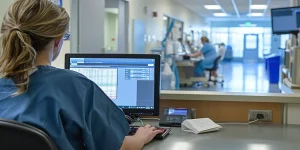Women face unique challenges in the healthcare system, particularly during patient onboarding. Integrated patient onboarding software targets these challenges. This technology streamlines health data collection and reduces administrative burden. It also provides personalized care, empowering women to take control of their health. By using Integrated software for patient onboarding, women can experience improved health outcomes and increased patient satisfaction. This leads to a more efficient healthcare system.
Key Takeaways
- Integrated patient onboarding software alleviates unique challenges women face during onboarding, improving health outcomes and reducing feelings of isolation.
- Streamlined health data collection reduces errors and increases efficiency, providing a seamless onboarding experience for women.
- Automation of administrative tasks reduces the burden on healthcare providers, allowing them to focus on delivering high-quality patient care.
- Personalized care plans are developed through integration, addressing the distinct needs of each woman and promoting better health outcomes.
- Empowered with access to personalized care, women can take control of their health, track metrics, and receive recommendations for improvement.
Patient Onboarding Challenges for Women
Numerous women encounter difficulties during the patient onboarding process, which can lead to feelings of frustration, anxiety, and disengagement. This complex process often involves filling out lengthy forms, providing medical history, and traversing unfamiliar healthcare systems. Women, in particular, may face unique challenges, such as managing family responsibilities, balancing work and personal life, and addressing cultural or linguistic barriers. As a result, they may struggle to access healthcare services, leading to delayed or foregone care.
The absence of a seamless onboarding experience can negatively impact women’s health outcomes, exacerbate existing health disparities, and perpetuate feelings of isolation. In contrast, integrated patient onboarding software can help alleviate these challenges by streamlining the process, providing personalized support, and fostering a sense of connection and belonging. By acknowledging and addressing these challenges, healthcare providers can create a more inclusive and supportive environment that caters to the unique needs of women, ultimately improving their overall well-being and quality of life.
Streamlining Health Data Collection
One of the most significant hurdles in the patient onboarding process is the collection of health data, which can be a time-consuming and laborious task for both healthcare providers and patients. This process often involves manual data entry, which can lead to errors and inaccuracies. Furthermore, patients may have to repeat their medical history multiple times, which can be frustrating and time-consuming.
Integrated patient onboarding software streamlines health data collection by automating the process, reducing errors, and increasing efficiency. Patients can easily input their health data through a secure online portal, which is then automatically populated into their electronic health record (EHR). This eliminates the need for manual data entry, reducing the risk of errors and inaccuracies. Additionally, patients only need to input their health data once, reducing the complexity and frustration associated with repeated data collection. By streamlining health data collection, Integrated software for patient onboarding improves the overall onboarding experience for women, allowing them to focus on their health and wellness.
Reducing Administrative Burden
As healthcare providers focus on delivering high-quality patient care, administrative tasks can often overshadow clinical responsibilities, taking away from the time and attention that could be devoted to women’s health and wellness. Implementing integrated patient onboarding software can notably reduce administrative burden, freeing up healthcare providers to focus on what matters most: providing exceptional care to their patients.
By automating and streamlining administrative tasks, healthcare providers can:
- Reduce paperwork and manual data entry
- Minimize errors and miscommunications
- Decrease wait times and improve patient flow
- Increase time spent on direct patient care and education
Personalized Care Through Integration
Streamlining patient data through Integrated software for patient onboarding sets the stage for delivering tailored care that acknowledges the unique needs and preferences of each woman. By consolidating patient information into a single, easily accessible platform, healthcare providers can gain a thorough understanding of each patient’s medical history, lifestyle, and personal goals. This integration enables providers to develop personalized care plans that address the distinct needs of each woman, fostering a sense of trust and understanding.

Integrated patient onboarding software also allows for seamless communication between healthcare teams, ensuring that all providers are on the same page regarding a patient’s care plan. This coordination enables providers to respond promptly to changing patient needs, making adjustments to care plans as necessary. By delivering personalized care through integration, healthcare providers can improve health outcomes, enhance patient satisfaction, and promote a sense of belonging among women. By leveraging the capabilities of Integrated software for patient onboarding, healthcare providers can create a tailored care experience that acknowledges the unique needs and preferences of each woman.
Empowering Women Through Technology
Women’s healthcare technology has undergone a significant transformation in recent years, with integrated patient onboarding software playing a pivotal role in empowering women to take control of their health. By leveraging technology, women can now access personalized care, schedule appointments, and communicate with healthcare providers with ease. This shift towards digital healthcare has enabled women to become more proactive in their wellness journeys.
- They can effortlessly access their medical records, track their health metrics, and receive personalized recommendations for improvement.
- Integrated software for patient onboarding allows women to complete paperwork and forms electronically, reducing wait times and streamlining the onboarding process.
- With secure messaging and video conferencing, women can connect with healthcare providers from the comfort of their own homes, reducing anxiety and increasing accessibility.
- By providing a seamless and intuitive experience, Integrated software for patient onboarding has become an essential tool in empowering women to take charge of their health and wellness.
Frequently Asked Questions
Can Integrated Patient Onboarding Software Accommodate Complex Medical Histories?
Yes, integrated patient onboarding software can accommodate complex medical histories by capturing exhaustive patient data, streamlining intake processes, and providing a centralized platform for healthcare providers to access and review detailed medical information.
How Does Integrated Software for Patient Onboarding Ensure Data Security and Privacy?
Integrated software for patient onboarding guarantees data security and privacy through robust encryption, secure data storage, and access controls, adhering to HIPAA guidelines, and regular security audits to protect sensitive patient information.
Is Integrated Patient Onboarding Software Compatible With Existing Healthcare Systems?
Integrated patient onboarding software is designed to be compatible with existing healthcare systems, ensuring seamless integration with electronic health records, practice management systems, and other healthcare technology platforms, promoting efficient data exchange and workflow optimization.
Can Integrated Software for Patient Onboarding Be Customized for Specific Healthcare Specialties?
Yes, Integrated software for patient onboarding can be tailored to meet the unique needs of specific healthcare specialties, allowing providers to create customized workflows, forms, and questionnaires that cater to their distinct patient populations and care protocols.
What Kind of Customer Support Is Typically Offered for Integrated Patient Onboarding Software?
Typically, integrated patient onboarding software providers offer thorough customer support, including online resources, phone and email support, and dedicated account management to guarantee seamless implementation and ongoing assistance for healthcare providers.
Conclusion
Integrated patient onboarding software offers numerous wellness benefits for women, addressing the unique challenges they face during the onboarding process. By streamlining health data collection, reducing administrative burden, and providing personalized care, this technology empowers women to take control of their health. Integrated software for patient onboarding alleviates the burden of health data collection, reduces administrative tasks, and provides personalized care, culminating in improved health outcomes, increased patient satisfaction, and a more efficient healthcare experience for women.
You May Also Like To Read:
